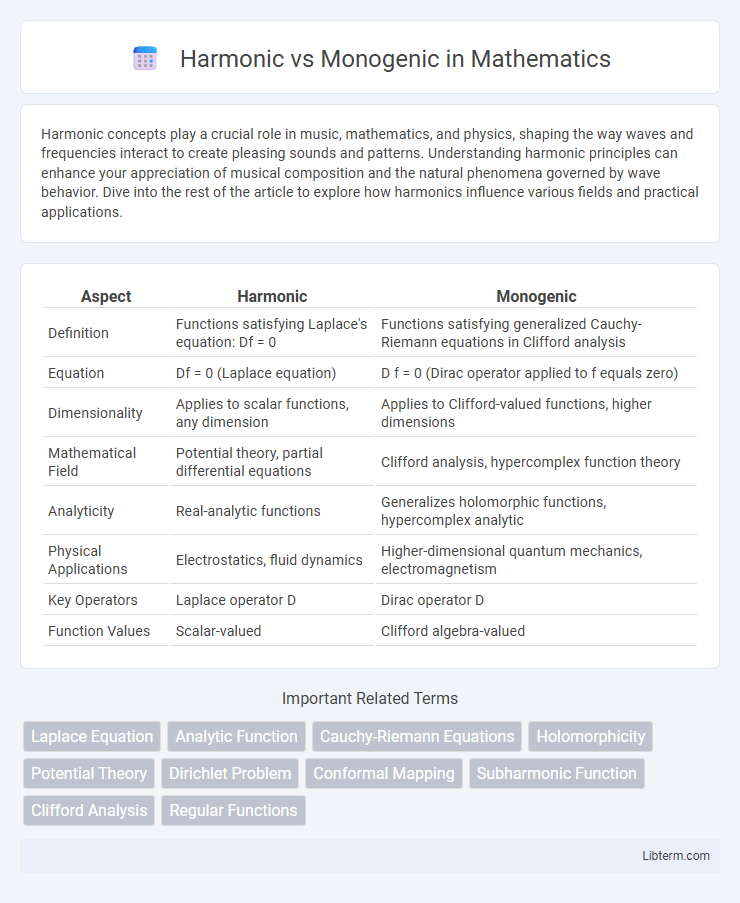Harmonic concepts play a crucial role in music, mathematics, and physics, shaping the way waves and frequencies interact to create pleasing sounds and patterns. Understanding harmonic principles can enhance your appreciation of musical composition and the natural phenomena governed by wave behavior. Dive into the rest of the article to explore how harmonics influence various fields and practical applications.
Table of Comparison
| Aspect | Harmonic | Monogenic |
|---|---|---|
| Definition | Functions satisfying Laplace's equation: Df = 0 | Functions satisfying generalized Cauchy-Riemann equations in Clifford analysis |
| Equation | Df = 0 (Laplace equation) | D f = 0 (Dirac operator applied to f equals zero) |
| Dimensionality | Applies to scalar functions, any dimension | Applies to Clifford-valued functions, higher dimensions |
| Mathematical Field | Potential theory, partial differential equations | Clifford analysis, hypercomplex function theory |
| Analyticity | Real-analytic functions | Generalizes holomorphic functions, hypercomplex analytic |
| Physical Applications | Electrostatics, fluid dynamics | Higher-dimensional quantum mechanics, electromagnetism |
| Key Operators | Laplace operator D | Dirac operator D |
| Function Values | Scalar-valued | Clifford algebra-valued |
Introduction to Harmonic and Monogenic Functions
Harmonic functions are twice continuously differentiable functions that satisfy Laplace's equation, playing a key role in potential theory and classical physics. Monogenic functions, defined within Clifford analysis, generalize holomorphic functions to higher dimensions by satisfying a generalized Cauchy-Riemann system. Both harmonic and monogenic functions exhibit properties of analyticity and smoothness, but monogenic functions provide a richer framework for multidimensional problems.
Fundamental Definitions and Concepts
Harmonic functions are solutions to Laplace's equation, characterized by the property that they are twice continuously differentiable and their second partial derivatives sum to zero, which means they exhibit mean value properties and are inherently smooth. Monogenic functions generalize harmonic functions in Clifford analysis, defined as null solutions to the Dirac operator, combining scalar and vector parts and extending complex holomorphic functions to higher dimensions. Understanding harmonic and monogenic functions is essential in mathematical physics and engineering for solving boundary value problems and analyzing multidimensional fields.
Mathematical Properties of Harmonic Functions
Harmonic functions satisfy Laplace's equation, ensuring they are twice continuously differentiable with zero Laplacian, which guarantees mean value properties and maximum principles. Unlike monogenic functions that generalize holomorphic functions to higher dimensions using Clifford algebras, harmonic functions maintain scalar-valued solutions essential in potential theory and classical physics. Their mathematical properties enable unique continuation, smoothness, and stability in boundary value problems.
Mathematical Properties of Monogenic Functions
Monogenic functions, central in Clifford analysis, are characterized by their satisfaction of the generalized Cauchy-Riemann system, extending holomorphic function properties to higher dimensions. Unlike harmonic functions, which satisfy Laplace's equation and represent scalar-valued solutions, monogenic functions are vector-valued and inherently encode more geometric information due to their multivector nature. This mathematical structure facilitates advanced applications in potential theory, signal processing, and multi-dimensional complex analysis by capturing both scalar and directional derivatives within a unified framework.
Key Differences Between Harmonic and Monogenic Functions
Harmonic functions satisfy Laplace's equation, making them twice continuously differentiable and used extensively in potential theory, whereas monogenic functions are solutions to the generalized Cauchy-Riemann system in Clifford analysis, extending complex analyticity to higher dimensions. Harmonic functions are scalar-valued and represent physical phenomena like gravitational and electrostatic potentials, while monogenic functions are Clifford algebra-valued, encoding more complex geometric information. The key difference lies in their domains and algebraic structures: harmonic functions operate in Euclidean spaces, whereas monogenic functions are defined on Clifford algebraic spaces, enabling richer multidimensional function theory.
Applications in Physics and Engineering
Harmonic functions play a crucial role in physics and engineering by modeling steady-state heat distribution, electrostatics, and fluid flow due to their Laplace equation solutions. Monogenic functions extend these applications through higher-dimensional analysis, enabling the study of wave propagation and elasticity problems via Clifford algebra. Both frameworks enhance computational techniques in signal processing and electromagnetic field analysis by providing robust methods for solving complex boundary value problems.
Analytical Techniques for Harmonic and Monogenic Analysis
Harmonic analysis employs Fourier transforms and spectral decomposition to analyze periodic components in complex signals, effectively breaking down waveforms into sine and cosine series. Monogenic analysis utilizes the Riesz transform and quaternionic signal representations to capture local amplitude, phase, and orientation in multidimensional data, providing enhanced feature extraction in image and signal processing. Both techniques leverage advanced integral transforms, but monogenic methods offer superior analysis for multidimensional, non-stationary signals compared to traditional harmonic approaches.
Visualization and Geometric Interpretations
Harmonic functions represent solutions to Laplace's equation and exhibit smooth, continuous surfaces ideal for scalar potential visualization, emphasizing equilibrium states with no local extrema inside the domain. Monogenic functions extend harmonic analysis to higher dimensions using Clifford algebras, allowing visualization through vector fields that encode multidimensional flow and rotation, enriching geometric interpretation beyond scalar potentials. The geometric interpretation of monogenic functions captures orientation and directionality in space, enabling more complex visualizations such as spinor fields and multivector-valued maps, which are crucial in physics and engineering applications.
Recent Advances and Research Trends
Recent advances in harmonic analysis emphasize refined techniques for signal decomposition, enabling enhanced feature extraction in complex datasets. Monogenic signal processing has attracted significant research interest due to its ability to provide intrinsic geometric representations, improving texture and shape analysis in multidimensional signals. Emerging trends concentrate on integrating harmonic models with monogenic frameworks to exploit complementary strengths for applications in computer vision and biomedical imaging.
Conclusion and Future Perspectives
Harmonic and monogenic signal analyses offer complementary tools for characterizing multidimensional data, with harmonic methods excelling in frequency domain representation and monogenic approaches providing robust local phase and amplitude information. Future developments in hybrid models integrating harmonic decompositions with monogenic feature extraction promise enhanced accuracy in image processing, pattern recognition, and signal classification tasks. Advancements in computational algorithms and real-time implementation will further expand applications in medical imaging, computer vision, and geophysical data analysis.
Harmonic Infographic

 libterm.com
libterm.com